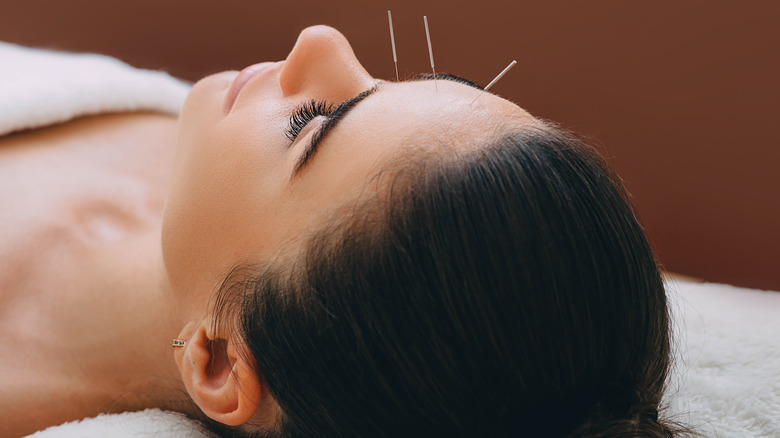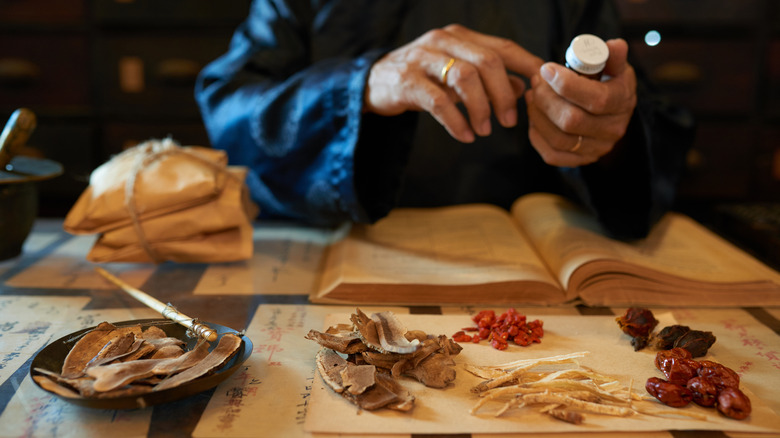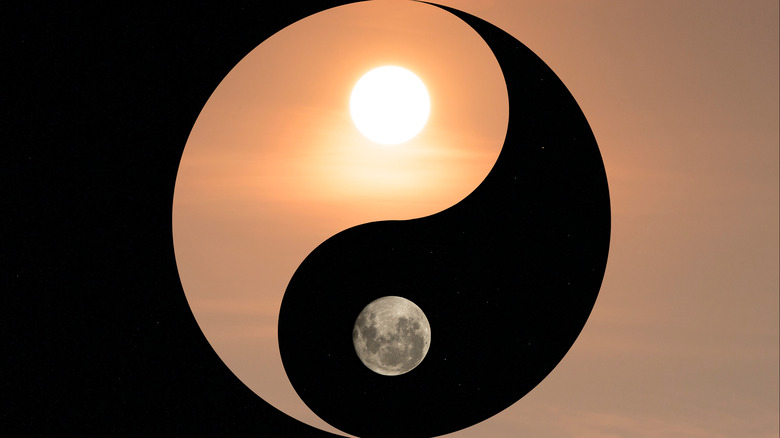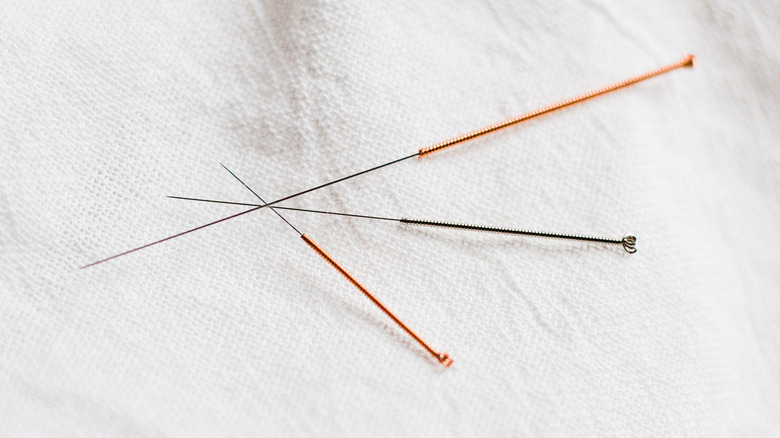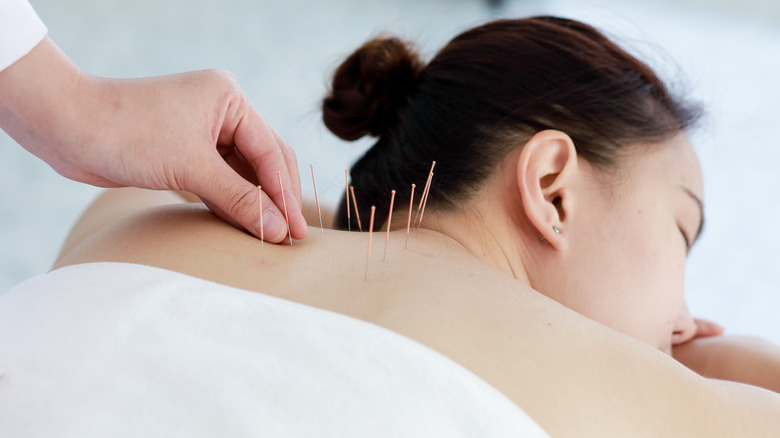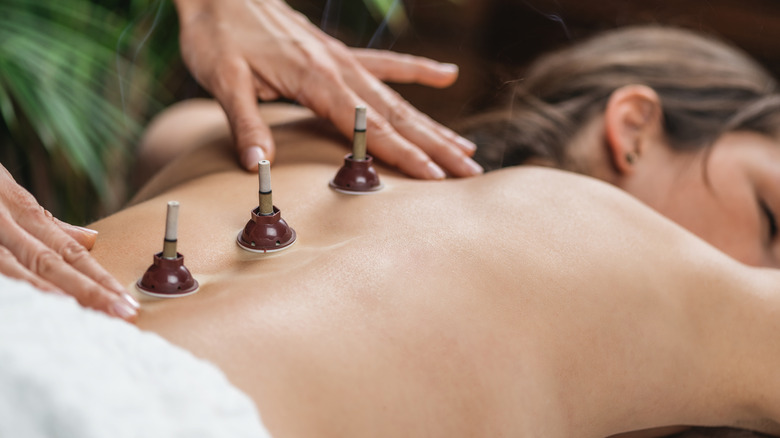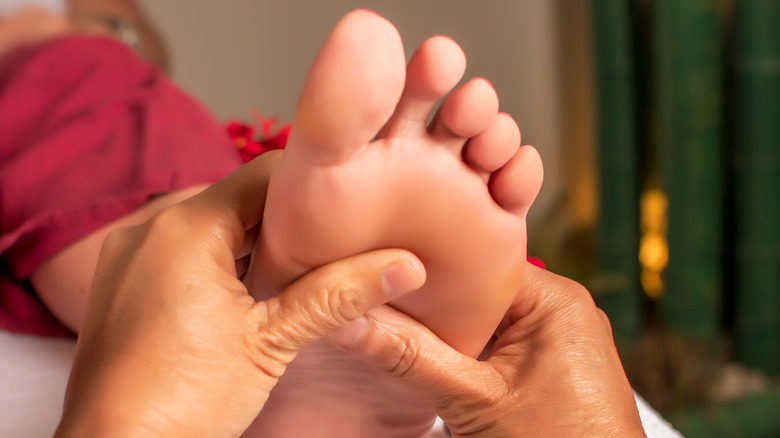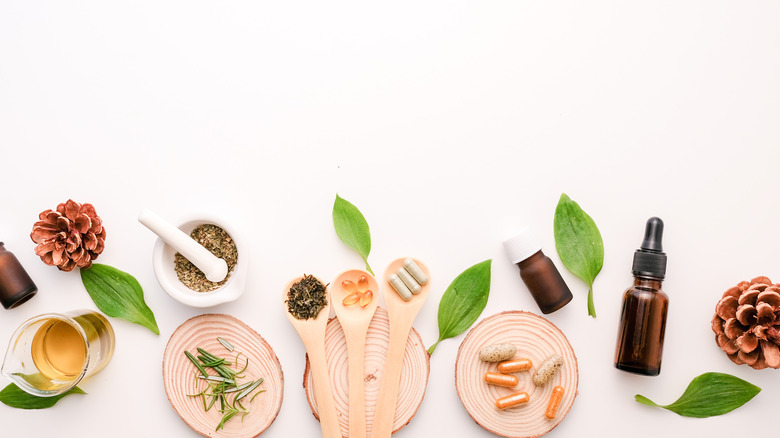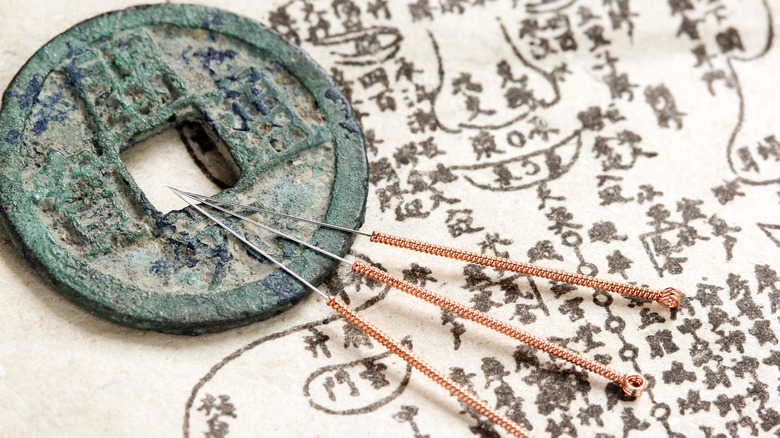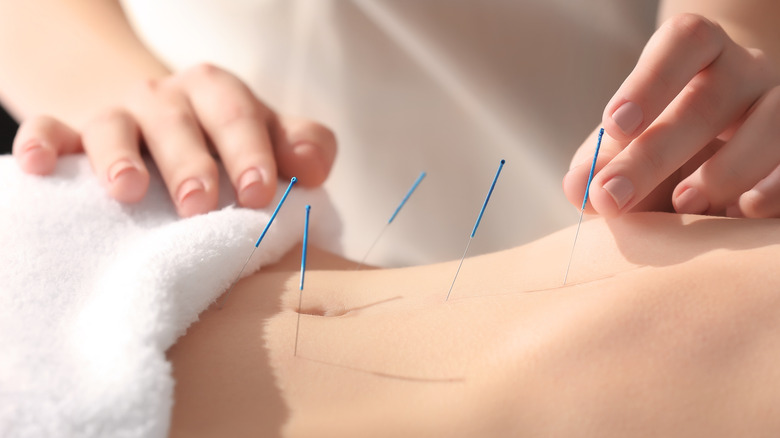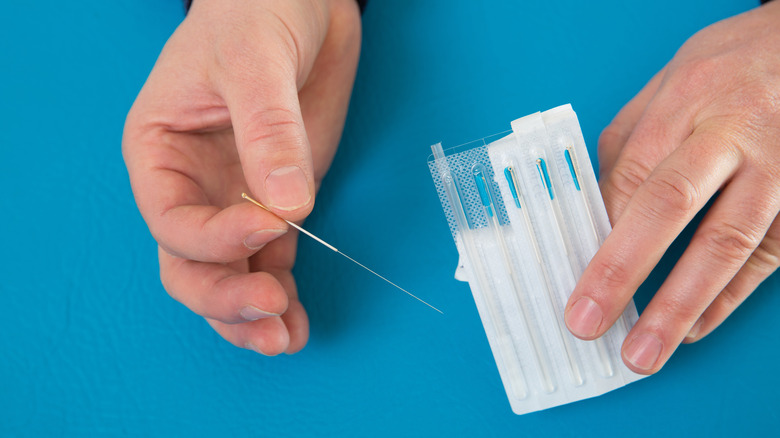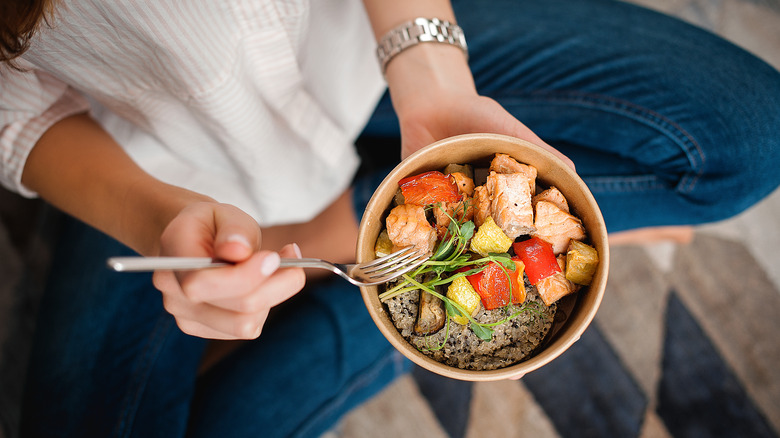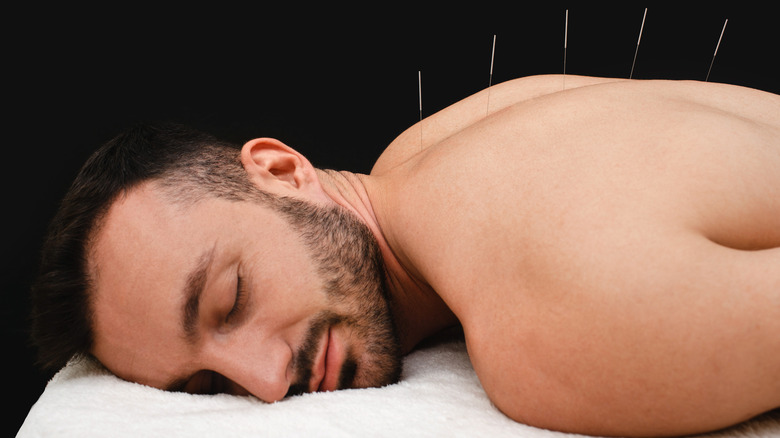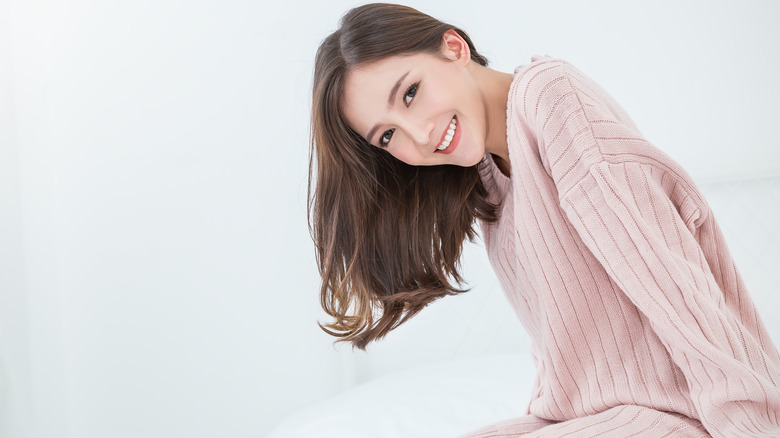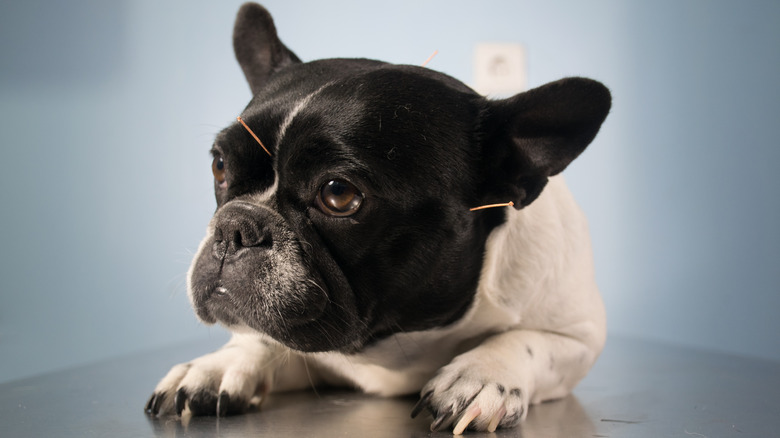What You Should Know About Acupuncture
Chances are you've heard of acupuncture. The world of Traditional Chinese Medicine (TCM) is far richer than just getting poked with needles and meditating. Though TCM is widely practiced, it remains somewhat esoteric in the states (via Mayo Clinic). It is, however, well regulated, so you can rest assured knowing that your practitioner has been through rigorous training to earn their credentials.
Acupuncture is one of the many elements of TCM, which is medicine rooted in ancient healing techniques. Doctors of TCM view the body holistically and work to heal the entirety of the body, not just a single symptom of illness. Chi, or energy, flows through your body along tiny highways called meridians. Each acupuncture point on each meridian is directly correlated to a visceral organ system (via Nature). As the Mayo Clinic explained, blocked energy pathways can cause illness, pain, and myriad other ailments. Acupuncture works by stimulating specific points along these energetic highways. This stimulation encourages the movement of chi, which can have exceptional healing benefits. Acupuncture is used to ease physical and energetic disharmony.
We rounded up all of the information you need to know about acupuncture. Armed with this knowledge, we hope you can decide whether or not it is right for you.
Acupuncture has a long history
According to Britannica, the principles of acupuncture were first created around 2500 BCE in China. Under the Ming Dynasty, throughout the 14th to 16th centuries, acupuncture and traditional Chinese medicine were at an all-time high in popularity. This is, in part, due to the publication of "The Great Compendium of Acupuncture and Moxibustion." This book outlines the deets of traditional medicines. As western medicine grew in the 17th century, people began to turn away from traditional medicines. By that time, though, the reach of TCM had extended far and wide, but often under the cloak of darkness (via News-Medical).
The Emperor's Decree in 1822 excluded acupuncture from medical training under the belief that it was laced with superstitions and fallacies. Acupuncture and other traditional medicines were actually outlawed in China in 1929. It wasn't until 1949, under Communist rule, that acupuncture was revived. As popularity spread, TCM was accepted into medical practices worldwide. The NIH published a study in early 1997 confirming what ancient practitioners already knew: Acupuncture can indeed work! From there, TCM has grown in popularity, though it has not yet been fully accepted by many western doctors (via UC San Diego School of Medicine).
It can treat many different things
Acupuncture is rooted in the ancient balance of yin and yang, a cosmic theory relating to duality (via Acupuncture Massage College). The yin is soft, dark, and feminine, and it is represented by the earth element. The yang is lively, sunny, energetic, and masculine, which is represented by the heavens. These two components come together to create perfect symmetry and harmony. This perfect balance of dualistic principles is what TCM is all about. The practice of acupuncture is manipulating these two forces to culminate in free-flowing, healthy, energetic pathways.
Acupuncture is said to stimulate self-healing by awakening specific acupressure/acupuncture points. Case studies have provided evidence that acupuncture can ease the symptoms and help treat many ailments (via UC San Diego School of Medicine). These conditions include but are not limited to hay fever, depression, morning sickness, hypertension, hypotension, low back pain, and more. Additionally, acupuncture has been shown to induce labor, assist in correcting fetal malposition, and more. Studies are ongoing, and there is some evidence to suggest that acupuncture may be able to ease the symptoms of alcohol dependence, acne, cancer pain, diabetes, and many more.
The needles are tiny
Because of our familiarity with western medicine, you may assume acupuncture needles are similar to needles used in hospital settings. The only other needles that come to mind are sewing needles. But both of these examples are much, much bigger than acupuncture needles.
"Acupuncture needles have an average diameter of 0.00325 inches," Inner Peace Acupuncture explained. "That's like a strand of hair." Put another way, many acupuncture needles are about 32 gauge (via Health CMi). For comparison, a standard IV needle is somewhere between 18 to 22 gauge; the higher the number, the thinner the needle.
We understand that knowing the size differences may not ease your mind very much if you happen to be a person who is intensely scared of needles. However, if the thought of acupuncture makes you nervous because you were picturing much larger needles, we hope this information will put you more at ease.
It doesn't hurt as much as you probably think
The idea of being prodded with needles repeatedly definitely doesn't sound like something one would rush to sign up for. In fact, acupuncture gets a bad rap based on that idea alone. However, acupuncture is far less painful than it sounds like it would be.
Not only are acupuncture needles tiny, but they remain on the surface of your skin. As such, the application usually doesn't draw blood. Occasionally, a needle will be placed in an area with many nerves, which can cause a slightly painful sensation. But as licensed and certified acupuncturist Prajna Paramita Choudhury told Healthline, "Most [people being treated] don't feel anything. Most of the time what might be described as pain is a chi sensation. It can be heavy, throbbing, or jumping, all of which are positive responses." Ultimately, the pain dissipates within a few seconds (via Healthline). While the mere concept of having someone stick needles in your skin is daunting, we can tell you that it's not as scary as it sounds.
It can be used with other modalities
Acupuncture is truly only one part of the whole traditional Chinese medicine equation. Often, doctors of TCM will use acupuncture in conjunction with modes of healing for overall balance. Cupping is one of the most popular complementary modalities used in TCM today. Cupping uses heated cups to create suction on your body (via WebMD). The warm glass cups are placed in specific locations. This stimulates blood flow in that area, which provides more oxygen to the area, explained the Cleveland Clinic.
Another complementary, albeit less widely practiced, modality is moxibustion. Moxa is made from ground mugwort leaves (Healthline). The powder gets compacted and shaped into a cone, which is then burned near acupressure and acupuncture points on your body. As with acupuncture, this is believed to stimulate the flow of energy along the meridians. TCM practitioners also use massage and herbal remedies in their treatments. Body movements, such as Tai Chi, are major components in holistic medicine as well.
Acupuncturists use more than needles
Acupuncturists often perform acupressure on their patients. Acupressure uses the same philosophies as acupuncture. It is all about holistically balancing the body by encouraging the flow of chi along the 12 meridians. Unlike acupuncture, acupressure is executed by exerting pressure with the fingers or a blunt acupressure device. Most commonly, acupressure is used to quell nausea and vomiting due to motion sickness. Acupressure has been proven to provide relief for many other conditions as well (via WebMD).
Since traditional Chinese medicine is holistic, acupuncturists survey the entire body when creating a treatment plan. Often in an appointment with an acupuncturist, you will be asked to stick out your tongue for a "tongue diagnosis" (via Verywell Health). The coating of your tongue changes, and it can be a reflection of what is going on deep within your body. You can expect your acupuncturist to look at your tongue and palpate your body in specific areas to get a better understanding of what might be causing your discomfort (per Verywell Health).
Acupuncturists may recommend medicinal herbs
Since acupuncture is only one piece of the traditional Chinese medicine pie, it is not uncommon for practitioners to recommend medicinal herbs to expedite or aid in healing. Many of the herbal remedies used in TCM are mild and effective. However, some of the herbs used can have serious side effects when combined with western medicine (via Johns Hopkins Medicine). Because of this risk, it is advisable only to receive acupuncture and TCM treatment from a licensed acupuncturist. The Accreditation Commission for Acupuncture and Oriental Medicine (ACAOM) accredits schools. Many TCM graduates can only become licensed if they graduate from a school accredited by the ACAOM.
It is important to disclose all medications to your TCM practitioner and medical doctor upon evaluation. This transparency will help both professionals safely prescribe or recommend treatments for your condition(s). Additionally, Johns Hopkins Medicine cautioned, "TCM should not be used as a replacement for conventional or allopathic treatment, especially for serious conditions, but it may be beneficial when used as complementary therapy."
No, acupuncture is not a religion
Acupuncture highlights the link between consciousness and organ function, which often attracts people looking to deepen their spirituality. This may make you wonder if acupuncture is its own religion (via Acupuncture Today). But, no, it's not. As the Blue Ridge Acupuncture Clinic explained, it's a misconception that "acupuncture and Chinese medicine are connected to or imply the use of eastern religion. While it is true that the history of acupuncture is diverse and that it originated in a culture embedded in Taoist, Confucianist and Buddhist thought, the same is true of western medicine which has its roots in Judaism, Christianity and Islam."
Of course, some acupuncturists may display Buddhist or Hindu icons, but many mainstream TCM institutions do not teach any Eastern philosophies as a part of their curriculum (via Acupuncture Today). And acupuncture can benefit people regardless of their religious beliefs. As the clinic further highlighted, "Acupuncture is a science, just as western medicine is a science, but it is a science of the flow of energetics within the body and it is based in thousands of years of observation."
It requires more than one session
If you have never been exposed to acupuncture before, you might be surprised to learn that it typically requires more than one treatment. "The simplistic response is, the longer the condition has affected you, the more time it will take to treat it," the Ache Institute explained.
Since the goal of acupuncture is to work to heal the root of the issue, not just the superficial symptoms, treatments may also last longer than your symptoms. Only you and your practitioner can decide how many treatments are right for you. Sometimes they will prescribe maintenance treatments as time goes on as well. As with all things, everyone's body responds differently. However, the Ache Institute revealed that acupuncturists like to "see progressive changes in the first 5 sessions. If there are no changes during this time, then this mode of therapy is unlikely to yield long term results with continuous treatment." Once you determine how your body responds to this form of healing, you and your practitioner can develop a personalized plan.
Each acupuncture needle is used only once
Since traditional Chinese medicine is not totally mainstream, the use of needles may seem unregulated. We understand that fear, but we are here to put your worried mind at ease. Acupuncture needles are disposable, meaning they're used only once (via American Institute of Alternative Medicine).
Reusing acupuncture needles is not standard practice and thus should absolutely not be tolerated. Doctors of Chinese Medicine are required to adhere to strict biohazard laws when it comes to treatments. This includes proper disposal of needles in a red sharps container (via Department of Environmental Protection).
Acupuncturists use sterile steel needles with each patient, the Cleveland Clinic detailed. During your treatment, you will be able to see your practitioner remove the needles from their sterile packaging. Acupuncturists hold the needles by the tightly wound coils atop each needle, which further prevents any risk of cross-contamination. We know that embarking on a new health journey can be scary. Thankfully, the notion of reusing acupuncture needles should never have to cross your mind again!
You should eat before treatment
If you are nervous about an upcoming acupuncture treatment, skipping a meal may sound like the best thing to do. Our stomachs tend to feel full of butterflies before trying something new, which doesn't entice us to eat. However, practitioners caution against arriving for treatment with an empty stomach (via Dr. Derek Kirkham). A key component of a successful treatment is relaxation. We all know from experience that it is difficult to relax if your stomach is constantly piping up and begging for a snack.
With healing in mind, Dr. Derek Kirkham, a licensed acupuncturist, recommends a light snack before treatment. Foods that have the potential to upset your stomach should be avoided, as they can detract from the overall relaxing experience. Kirkham advises against eating greasy foods or large meals, in particular. Of course, you know your body best. Armed with this information, we are confident that you can regulate your hunger and feed your body appropriately before receiving acupuncture.
It is a great time to chill
You may be surprised at the lag time you experience on the acupuncture table. Typically, a practitioner will place their needles and then give you space. This leaves you alone in the room with only your thoughts to keep you company — gasp. Most practitioners leave the needles in place for 10 to 20 minutes and expect you to focus on relaxation during that time (via Mayo Clinic).
Your acupuncturist may also ask you to silence your phone (via Shen Medicine). It isn't easy to scroll or text with those needles in place anyway. As a part of the healing process, doctors of traditional Chinese medicine generally provide an environment conducive to relaxation. Typically the lights are dimmed, and there may be soft, instrumental music playing in the background, explained Kaiser Permanente.
The best thing to do when left alone during a session is to relax consciously. This looks different for everyone, but many acupuncturists offer breathing tips to aid in the process. During your session, it is advisable to lean into the gift of relaxation. Your ability to relax will help yield many beneficial results that acupuncture can offer.
It is best to wear loose clothing
Since the 12 meridians span the entirety of the body, acupuncturists may have to needle places that are hard to reach on patients wearing tight-fitting clothes. Because of this, the American Institute of Alternative Medicine advises patients to wear loose, comfortable clothing that can be easily pushed to the side. Many of the acupuncture points that your practitioner will access are on your arms, legs, and abdomen. It is easier for you and your acupuncturist if you plan ahead by wearing clothing that offers access to these areas.
You will be able to remain fully clothed during your acupuncture treatment; however, if your acupuncturist chooses to perform cupping in addition to acupuncture, you may need to remove some clothing, as Elliott Therapeutics explained. Most practitioners have a lot of experience with this, of course, and it is no less awkward than getting a massage.
Even your pets can get acupuncture
Veterinary acupuncture has become more popular in recent years. While this is an easy notion to dismiss, a report in Veterinary Medicine revealed that acupuncture can have huge benefits in animals too. Much research has focused on neurological dysfunction or orthopedic pain in lab animals, and acupuncture may be able to aid in joint mobility in dogs with arthritis. "Given the low risk of adverse effects and observed benefits for animal health and well-being, acupuncture should be considered as a potential tool in all veterinarian treatment strategies," the report revealed.
Unfortunately, you can't take your pet with you to your acupuncturist for a doggy-and-me session. Only veterinarians are allowed to perform acupuncture on animals. Licensed vets can attend a special veterinary acupuncture course and earn a certification to practice on pets (via Tufts University). We are going to round up our cats and go check out veterinary acupuncture right meow!

